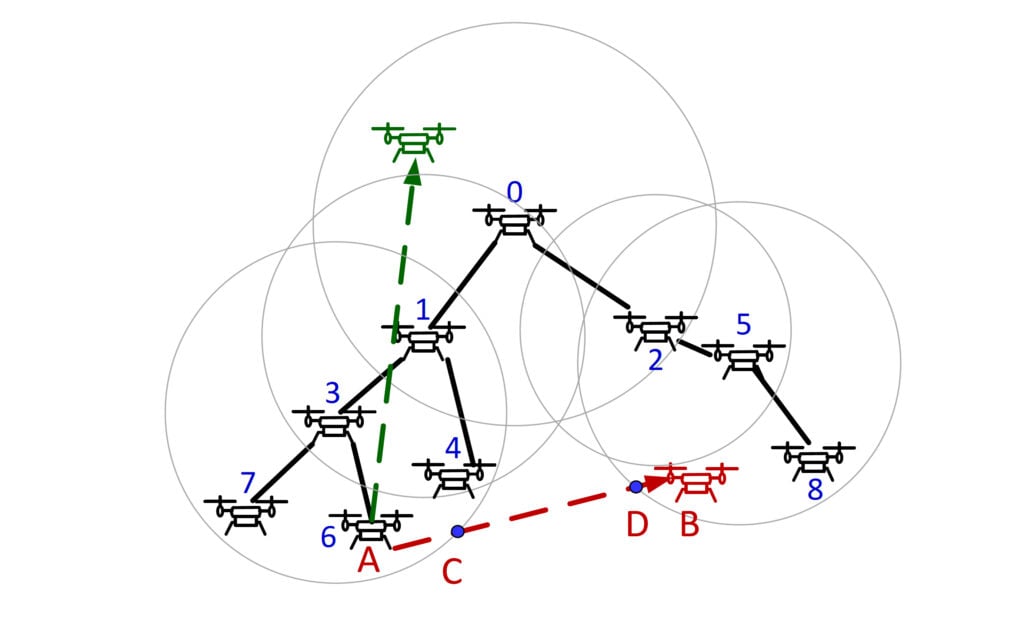
There are many studies employing Unmanned Aerial Vehicles (UAVs) to support Internet connectivity. Particularly, in geographically isolated regions that are outside of the coverage of modern communication infrastructure, UAVs can form a one-time-cost aerial mesh network facilitating services such as human rescue, battling wildfires, videography, and more.
Such aerial networks often need to deal with UAVs’ mobility to meet application expectations such as capturing scenes from different viewing angles, zooming in/out, and so on. While UAVs move to carry out tasks, they often need to stay connected to the aerial network in order to share information. It is therefore necessary to handle UAV transitions seamlessly — to maintain continuous network connectivity during movement — in aerial mesh networks.
What are the challenges and opportunities?
One of the major concerns arises from the limited power supply that a UAV may have. Existing UAVs are battery-powered. To enable UAVs to reliably connect to the network, the process of UAV transitions should be energy efficient. Furthermore, to handle time-sensitive tasks, the process of UAV transitions should be simple yet effective. In particular, when UAVs are not equipped with very powerful CPUs, transitions with low-computational complexity will benefit the performance of all other UAV tasks.
As flying consumes power quickly, a shorter UAV moving trajectory will be more energy efficient. Aerial communications provide advantageous environments in achieving this perspective. Because of the limited obstacles in the sky, UAVs can potentially move via straight lines to travel the shortest distances between two locations. However, straight-line trajectories may not always be seamless (Figure 1).

As shown in Figure 1, the green dotted arrow line illustrates a straight-line trajectory that is seamless (passing through the combined coverage of different UAVs) but the red dotted arrow line shows a straight-line trajectory that is not seamless as the part between C and D is not covered by a UAV. Therefore, the questions are:
- Is a straight-line trajectory seamless or not?
- How can a short yet seamless transition trajectory be formed?
We can gain some insight by looking into these issues.
Is a straight-line trajectory seamless?
Obviously, a straight-line trajectory is seamless if it passes through the combined coverage of a series of UAVs with overlapping coverage. Referring again to Figure 1, the determination of whether a straight-line trajectory passes through such combined coverage can refer to the distances between A and C, B and D, and A and B. In Figure 1, C (D) represents the intersection between the straight line A->B and the coverage of UAV3 (UAV5). UAV3 and UAV5 cover the starting and the destination locations respectively. More specifically, when the distance summation of A to C and D to B is not less than the distance A to B, the straight line A->B seamlessly passes through the combined coverage of UAVs covering the starting and the destination locations.
When the distance summation of A to C and D to B is greater than the distance A to B, the coverage of the two UAVs covering the starting and the destination locations does not overlap. Therefore, if part of the straight line is outside of the coverage of the two UAVs covering the starting and the destination locations, the straight-line trajectory is seamless. Otherwise, vice versa. We can design a checking algorithm that is able to employ the minimum number of UAVs in the aerial network to check the seamlessness of C->D, benefitting transitions with short delays.
Establish seamless trajectories with short travel distances
To establish a new trajectory between two locations covered by two UAVs that have overlapping coverage, a simple yet effective way is to guide the mobile UAV to move to a location inside the coverage overlap of the two UAVs.
Ideally, the location should minimize the travel distance. Such a location may be achievable by an existing mathematical algorithm (for example, a polynomial-based algorithm, or a non-polynomial algorithm) that can seek a point on the surface of an overlap that has the shortest distance to a straight line. However, the endeavour to obtain such optimal solutions potentially increases transition delays. For applications with strict delay requirements, some heuristic transition locations may be employed.
In our research study, we propose a method to achieve a transition location by simple computational tasks such as solving quadratic equations, without sending new overheads to the aerial network.
To establish a new trajectory between two locations covered by two UAVs that do not have overlapping coverage, more UAVs in the network should be used to provide coverage for the transition. An effective solution is a chain of UAVs whose coverage overlaps one by one, providing a combined coverage that the mobile UAV may travel through without disconnecting from the network. Algorithms such as Dijkstra’s algorithm and the A* algorithm can be applied to search for the minimum number of UAVs to form such a chain. On this chain, for any two UAVs that have overlapping coverage, the above-mentioned method that searches for transition locations inside overlaps can be applied to parts of the new trajectory.
Dr Wanqing Tu is an Associate Professor in the Department of Computer Science at Durham University, UK.
The views expressed by the authors of this blog are their own and do not necessarily reflect the views of APNIC. Please note a Code of Conduct applies to this blog.
